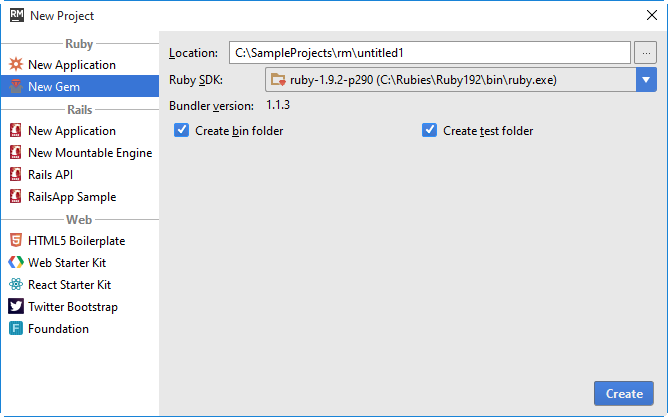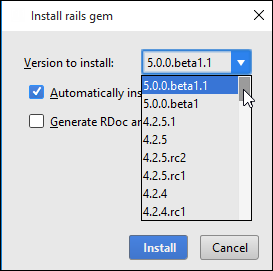Creating Rails-Based Projects
In this section:
Basics
In RubyMine, one can create several Rails-based project types.
- Rails applications are intended for productive web development with Ruby on Rails.
- Rails mountable engine projects are used to provide additional functionality to their host applications.
- Rails API projects are intended for building REST APIs with Rails.
- RailsApp Sample projects are intended for mastering Rails.
Creating Rails-based projects
To create a Rails-based project, follow these general steps
- Do one of the following:
- On the main menu, choose
- Click the New Project button in the Welcome screen
- In the Create New Project dialog box, specify the project name and location.
In the Project type drop-down list, select the desired Rails-based project type.

- Specify the following:
- In the Project SDK drop-down list, select the Ruby SDK you want to use from the list
of available Ruby interpreters, installed on your computer.
Refer to the section Configuring Ruby SDK for the procedures of installing interpreters.
If the desired Ruby interpreter is not found in the list, you can specify a new one by clicking the button New..., and locating Ruby SDK in the file system.
- In the Rails Version drop-down list, select the desired Rails version from those
installed on your machine.
If the desired version is missing, choose Install Rails Gem... command from the drop-down list. RubyMine downloads the list of gems. Next, you have to choose one from the drop-down list in the Install rails gem dialog box:

- In the field Rails Template, type the fully qualified path to the desired template
file, or click the button
 , and locate the template file in the file system.
, and locate the template file in the file system.
- For the New application and New mountable engine project types , you can select the JavaScript library to be used to generate the target application.
- For the New application
, New mountable engine
or Rails API project types, specify which database will be used for your new
application.
By default, RubyMine suggests using SQLite3. If you want to use a different database, select the Preconfigure for the selected database check box, and choose the desired database from the drop-down list.
- For the New application
and New mountable engine project types, specify whether
RubyMine should generate the testing directory structure and template files.
To do that, select or clear the check box Skip Test::Unit files.
If you leave the check box cleared, RubyMine will produce the
testfolder, marked as a test root , with all the
necessary infrastructure. If you select this check box, the testing infrastructure will not be
generated.
, with all the
necessary infrastructure. If you select this check box, the testing infrastructure will not be
generated. - For the RailsApps Sample project type, select the sample type from the list of available types.
When ready, click Create. The generator executes and displays its output in the console of the Run tool window.
- In the Project SDK drop-down list, select the Ruby SDK you want to use from the list
of available Ruby interpreters, installed on your computer.
Refer to the section Configuring Ruby SDK for the procedures of installing interpreters.
Creating Rails samples
If you are going to study Rails, choose the option RailsApps Sample. Specify the project location and Ruby SDK, and then choose the exact sample project.
If there are changes to the list of sample projects, click ![]() .
.
Notes for OS X and Linux users:
- When choosing the project interpreter, keep in mind that Ruby version may be different from the one
provided in the file
.ruby-version. - If you choose
rvmwith the a gemset, note that this gemset applies to the file.ruby-gemset.
In both cases, RubyMine provides the ability to revert:
